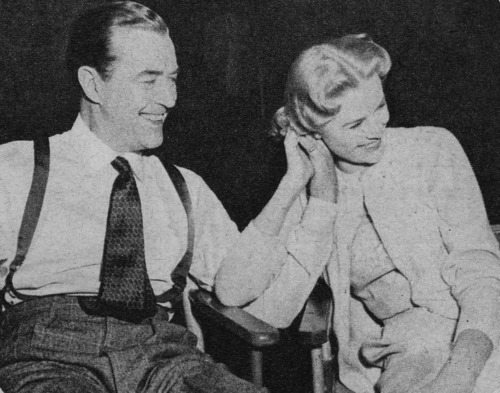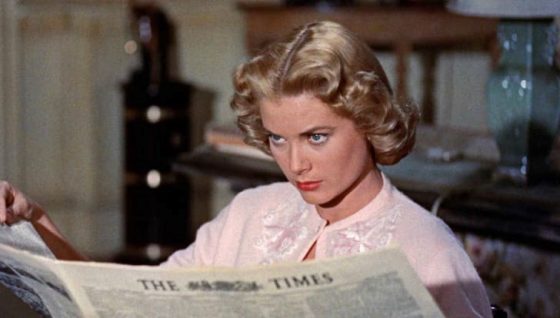Filmed in 3D ‘Dial M for Murder’ is an intriguing thriller that is in many ways a perfect choice for Alfred Hitchcock as he is able to handle the twists to the plot with great aplomb. The scene where Grace is to be murdered and then manages to turn, grab the scissors and kill her assailant is handled very well indeed – but this would be ‘egg and milk’ to this Director.
We in the audience know what is going on – but how will Ray Milland be found out ?
The tension builds – will he finally be exposed ?
During the filming of Dial M for Murder’ Grace Kelly soon found herself the subject of the gossip columns because of her closeness to her leading man, forty-nine-year-old Ray Milland who had been an Oscar winner in 1945 for The Lost Weekend, and he was well liked in Hollywood.
Ray Milland had married the former Murial Weber in 1932, and they had a son, Daniel, born 1940, and a daughter, Victoria, adopted in 1949.
Ray Milland was particularly susceptible to Grace Kelly’s considerable charms, – who wouldn’t be – and he fell in love with her and likewise Grace with Ray. “It was very serious between Ray and Grace,” [Grace’s sister] Lizanne recalls. They began to see each other, making little effort to conceal their romance.
Ray Milland surprised Lizanne – Grace Kelly’s sister – one day by confiding the depth of his feelings for Grace to her. “I flew back from Hollywood on the same plane with him,” she recalls, “and we had a long talk. He told me he really was very much in love with her.”

On the set of ‘Dial M for Murder – the two do look to be getting on very well indeed
Gossip in Hollywood tended to spread like wildfire and Ray Milland’s wife, known to her friends as Mal, soon heard talk about her husband and this beautiful newcomer. She feared it was true, but there was no proof. Several weeks after her suspicions were first aroused, her fears were confirmed. A close friend of the Millands, who requested anonymity, recalls: “Ray was going on a trip, and he had just left the house. Mal’s sister Harriet was there, and Mal poured her heart out to her about her suspicions. Harriet got in her car, followed Ray to the airport, and sure enough, there was Ray with Grace, going off on a tryst somewhere.”
The Millands separated – Grace and Ray discussed marriage. He took an apartment in Hollywood and Grace spent a great deal of time there. One of the publicists at Paramount at the time, said, “I don’t know if they were living together, but the story got back to me that someone from the studio went over to Ray’s apartment and Grace answered the door.”
It wasn’t the publicity, which the veteran Ray Milland was more used to and less affected by than Grace was, but rather his realisation of the impracticality of his divorcing Mal that caused him to reconsider. Studio publicist Andy Hervey recalls that Mrs. Milland had an ace up her sleeve: “Mal told Ray, ‘You go ahead and get a divorce and marry Grace Kelly. That’s okay with me, because all the property is in my name.’ Needless to say, it wasn’t long before the marriage plans were off.”
Grace Kelly had wanted to marry Ray Milland, and she was convinced that he would leave his wife and marry her.
That did not happen as we all know.
Rather a sad story – as this does seem to have been true love for them both – but it was not to be
Now back to the film ‘ Dial M for Murder’
Dial M for Murder would ultimately become one of Hitchcock’s best-known—and best-loved—classics.
The film is, in terms of locations and number of characters, quite a sparse film that barely leaves the studio set. This is because it was based on a stage play by Frederick Knott, which premiered as a BBC TV special in 1952 and later opened at London’s Westminster Theatre and, eventually, Broadway. After seeing the BBC production, producer Sir Alexander Korda acquired the rights to make the film version, and later sold them on to Warner Bros. for $75,000.
In the early 1950s, the 3D film craze was raging, and Warner Bros. were keen for Hitchcock to direct, sensing this was just up his street, although they also insisted that he use the 3D process on Dial M for Murder.
It meant that Hitchcock had to work with the giant cameras necessary for the process.
In order to make the film look interesting in 3D, Hitchcock used a pit into the floor of the set, so the camera could move at lower angles and capture objects like lamps in the foreground. As a result, the film looks different to any other that Hitchcock ever shot, particularly for the famous scissors murder scene. Unfortunately, by the time Dial M for Murder was released in 1954, the 3D fad was dying out, so the film was shown in 2D at most screenings.
Would love to see it in 3D – Wonder if such a print exists – I bet it does.
THIS WAS HITCHCOCK’S FIRST FILM WITH GRACE KELLY.
Of all of the iconic blonde stars Hitchcock cast in his films, the most famous one must be Grace Kelly, the actress-turned-princess.
He described her as a “rare thing in films … fit for any leading-lady part,” and it was said he had the easiest working relationship with her of any star. They worked so well together that they went on to make two more films
Rear Window in 1954 and To Catch a Thief in 1955.
Because Dial M for Murder is based on a stage play, the original script had very little in the way of outdoor set pieces. Hitchcock wanted to keep it that way.
“I’ve got a theory on the way they make pictures based on stage plays; they did it with silent pictures, too. Many filmmakers would take a stage play and say, ‘I’m going to make this into a film.’ Then they would begin to ‘open it up.’ In other words, on the stage it was all confined to one set, and the idea was to do something that would take it away from the confined stage setting.”
Hitchcock wanted to keep the confinement intact, so almost all of the action in the film takes place indoors, largely in the Wendices’ apartment. This adds to the tension.
Hitchcock was always known as a meticulous director obsessed with detail, but on ‘Dial M for Murder’ even more so, in part because the 3D cameras were going to capture objects in a way his other films hadn’t and because of this he selected every item in the Wendice apartment himself.
He also had a giant false telephone dial made for the famous “M” close-up in the title sequence.
Hitchcock’s exacting eye also led him use the Colour to portray the psychological condition of Grace Kelly’s character. As the film begins, the colours she wears are all very bright, suggesting a happy life in which she doesn’t suspect anything is wrong. As the film grows darker for her, to the point that she’s framed for murder, the wardrobe grows darker and “more sombre,” as Hitchcock put it.

For the scene in which Swann (Anthony Dawson) attempts to murder Margot (Kelly) by strangling her (until she manages to stab him with a pair of scissors), Hitchcock had another exacting wardrobe request. He had an elegant velvet robe made for her, hoping to create interesting textural effects as the lights and shadows played off the fabric while she fought for her life. Kelly reasoned that, since Margot was alone in the apartment (as far as she knew) and was only getting out of bed to answer the phone, she wouldn’t bother to put on a robe.

“I said I wouldn’t put on anything at all, that I’d just get up and go to the phone in my nightgown. And [Hitchcock] admitted that was better, and that’s the way it was done,” said Grace Kelly later
Dial M for Murder had a very short shooting schedule – 36 days. The director took special care with one scene in particular: the murder sequence in which Margot stabs Swann with the scissors. Not only was it a key scene in the film, but it was also a moment that required particular care to make the 3D effects work. Hitchcock agonised over the scene to such a degree that he was reputed to have lost weight as a result – it certainly wouldn’t have done him any harm !!
As for Hitchcock’s famous cameo appearances in his films – In Dial M for Murder he appears in a class reunion photograph in the Wendice apartment, seated at a banquet table among other men.
Place your comment